» posted on Tuesday, November 13th, 2012 by Linda Lou Burton
Here’s The Beef
 Linda Burton posting from Oklahoma City, Oklahoma – “Just climb those steps and walk the walkway over the pens. The auction is in that red barn over yonder.” Those directions were followed by a good squirt-through-the-teeth spit onto the ground and a nod towards a large red barn. Way over yonder. I climbed the steps as high as the walkway, but vertigo took over then. A small group of handsome black cattle stood penned below me; ears tagged; beyond them more cattle in brown; and way beyond that, the red auction barn. They stared at me and I stared back, each of us wondering where they were headed next. A man approached the steps wearing a long pony tail and a high-powered camera; I asked what he was planning
Linda Burton posting from Oklahoma City, Oklahoma – “Just climb those steps and walk the walkway over the pens. The auction is in that red barn over yonder.” Those directions were followed by a good squirt-through-the-teeth spit onto the ground and a nod towards a large red barn. Way over yonder. I climbed the steps as high as the walkway, but vertigo took over then. A small group of handsome black cattle stood penned below me; ears tagged; beyond them more cattle in brown; and way beyond that, the red auction barn. They stared at me and I stared back, each of us wondering where they were headed next. A man approached the steps wearing a long pony tail and a high-powered camera; I asked what he was planning  to shoot. “Cows and cowboys,” he answered. “I’m just looking for something interesting.” He proceeded along the walkway over the cattle pens, headed for the red barn. The morning auction went on without me; I more sure-footedly explored Stockyards City from a ground-level view. Later I caught up with the crowd at Cattlemen’s Steakhouse, where cowboys and cattlemen have been going since 1910.
to shoot. “Cows and cowboys,” he answered. “I’m just looking for something interesting.” He proceeded along the walkway over the cattle pens, headed for the red barn. The morning auction went on without me; I more sure-footedly explored Stockyards City from a ground-level view. Later I caught up with the crowd at Cattlemen’s Steakhouse, where cowboys and cattlemen have been going since 1910.
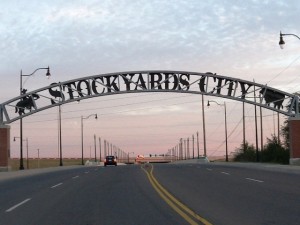 Just three years after Oklahoma became a state, Stockyards City was founded; the date was October 3, 1910 and the location was two miles west of Oklahoma City. The Edward Morris Company set up a packing plant and a livestock sales terminal; soon Wilson and Armour had huge packing facilities there too. Cattle, hogs and sheep were transported first by cattle drive; later by railroad and truck. In the beginning livestock sales were only by private agreement between seller and buyer through on-premises commission companies.
Just three years after Oklahoma became a state, Stockyards City was founded; the date was October 3, 1910 and the location was two miles west of Oklahoma City. The Edward Morris Company set up a packing plant and a livestock sales terminal; soon Wilson and Armour had huge packing facilities there too. Cattle, hogs and sheep were transported first by cattle drive; later by railroad and truck. In the beginning livestock sales were only by private agreement between seller and buyer through on-premises commission companies. 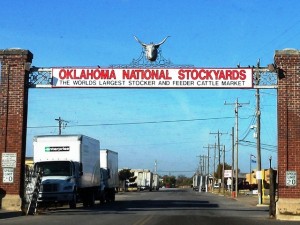 When the auction mode of trade was added in 1961, that greatly upped the competition for available livestock. The Oklahoma City livestock market grew to become the world’s largest market of stocker and feeder cattle, with yearly receipts of over half a million head; more than 102,000,000 head of livestock have passed through the Stockyards gates.
When the auction mode of trade was added in 1961, that greatly upped the competition for available livestock. The Oklahoma City livestock market grew to become the world’s largest market of stocker and feeder cattle, with yearly receipts of over half a million head; more than 102,000,000 head of livestock have passed through the Stockyards gates.
Another thing happened in 1961. The packing plants, faced with the need for overhaul and updating of equipment, decided to close. But the cattle trading remained profitable; as well as the cattle related businesses, such as Langston’s Western Wear, opened in 1916; back then it was called “The Friendly Store.” The Stockyards area has always been 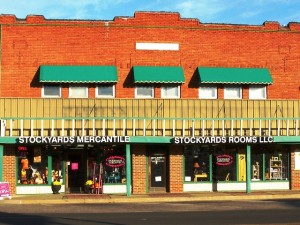 the place for cattlemen, horsemen, farmers, ranchers, and cowboys to come for clothing, equipment, supplies, and a good meal. Which leads to the story of Cattlemen’s Steakhouse.
the place for cattlemen, horsemen, farmers, ranchers, and cowboys to come for clothing, equipment, supplies, and a good meal. Which leads to the story of Cattlemen’s Steakhouse.
As the area began to develop in 1910, Cattlemen’s was one of the few places that stayed open after sundown, a popular gathering spot at the end of a working day. It attained an added popularity during prohibition – it attracted clientele seeking “liquid delights” as well as a good steak. Cattlemen’s changed hands in a dice game in 1945 when an area rancher by the name of Gene Wade threw a “hard six” and suddenly found himself in the restaurant business! The “33” brand on the walls became a well-known symbol of his good fortune. Rooms have been added over the years as the business continued successful, building on its reputation of “the perfect steak,” which it describes this way: Start with the finest Midwest-raised corn-fed beef, USDA 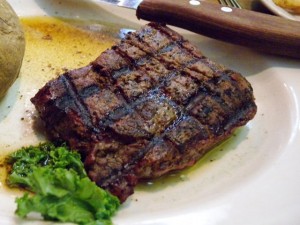 Prime or Choice Grade. Slowly age (according to a closely-guarded house secret). Never frozen, the handcut steak is then broiled over a sharp, hot flame from real charcoal; it finishes the meat to a sear on the outside and is juicy and tender within.
Prime or Choice Grade. Slowly age (according to a closely-guarded house secret). Never frozen, the handcut steak is then broiled over a sharp, hot flame from real charcoal; it finishes the meat to a sear on the outside and is juicy and tender within.
The restaurant opens at 6 AM – at the first crow of the rooster; morning fare includes homemade biscuits and gravy, eggs and grits and ranch-style potatoes; bacon, sausage, ham, and naturally, steak. You’ll find travelers and truck drivers, working cowboys and ranchers, bankers and bigwigs enjoying a Cattlemen’s meal nearly any time of day; everyone who wants a good meal and an interesting place to eat! Do you want to try some lamb fries? (If you don’t know what they are, don’t ask.)
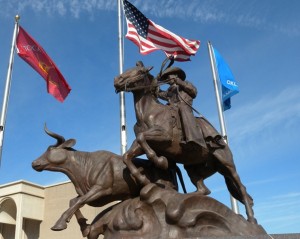 Stockyards City is a “working” tourist attraction. Real business is going on here; the stores support the cattle trading work; besides good food it’s where you go for boots and hats and belts and buckles and everything in between; saddle making and repairing are done right here. If it’s not on the shelf, highly skilled craftsmen can make it. Here you’ll find Rodeo Opry on Saturday nights and Cowboy Church on Sundays; Stockyards City is also headquarters for the International Professional Rodeo Association (IPRA), one of the two rodeo sanctioning bodies in America, which oversees more than 400 rodeo events each year.
Stockyards City is a “working” tourist attraction. Real business is going on here; the stores support the cattle trading work; besides good food it’s where you go for boots and hats and belts and buckles and everything in between; saddle making and repairing are done right here. If it’s not on the shelf, highly skilled craftsmen can make it. Here you’ll find Rodeo Opry on Saturday nights and Cowboy Church on Sundays; Stockyards City is also headquarters for the International Professional Rodeo Association (IPRA), one of the two rodeo sanctioning bodies in America, which oversees more than 400 rodeo events each year.
About Cattlemen’s Steakhouse http://www.cattlemensrestaurant.com/
About Oklahoma National Stockyards http://www.onsy.com/
Here’s The Beef
The Market Report for Oklahoma City, OK Mon Nov 12, 2012 USDA-OK Dept of Ag Market
Oklahoma National Stockyards, Oklahoma City, OK. – Open Feeder Cattle Auction Narrative Report for Mon 11/12/2012
Estimated Receipts: 7850 Last Monday: 10,846 Yr Ago Monday: 8869
Compared to last week: Feeder cattle and calves not well tested in early rounds. Early demand moderate. Early supply has included several bulls.
Feeder Steers Medium and Large 1: Calves: lot 370 lbs 197.00; 415 lbs 186.00; lot 490 lbs 175.50; 545-600 lbs 147.00-169.00, few lots fleshy 143.00; few 650-675 lbs 140.00-142.00; 715 lbs 141.75; Yearlings: 600-700 lbs 145.00-150.00; lot 845 lbs fleshy 133.00.
Feeder Heifers Medium and Large 1: Calves: few 300-400 lbs 177.00-179.00; 445-500 lbs 148.00-156.00; 500-600 lbs 134.00-142.50; 600-700 lbs 124.50-135.00; Yearlings: load 670 lbs 138.25; lot 755 lbs 132.25.
Source: USDA-Oklahoma Dept of Ag Market News Oklahoma City, OK

